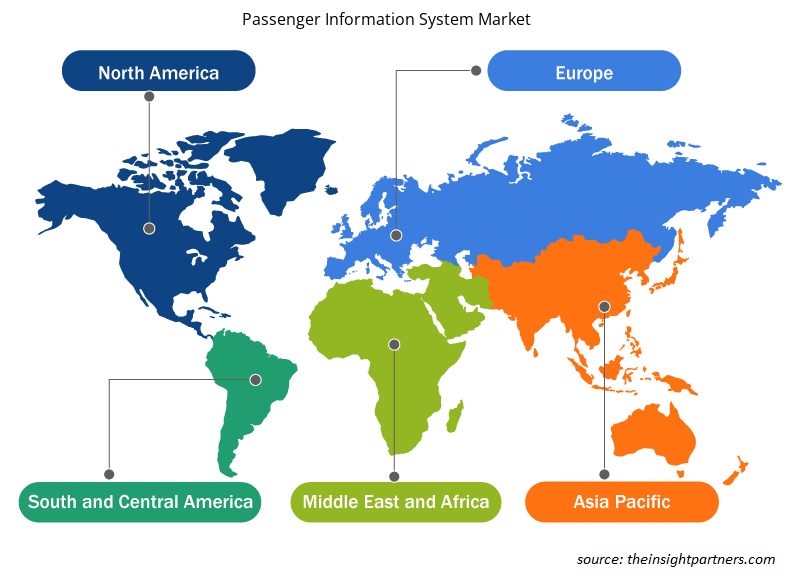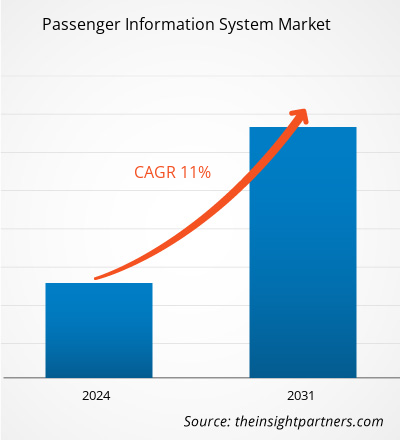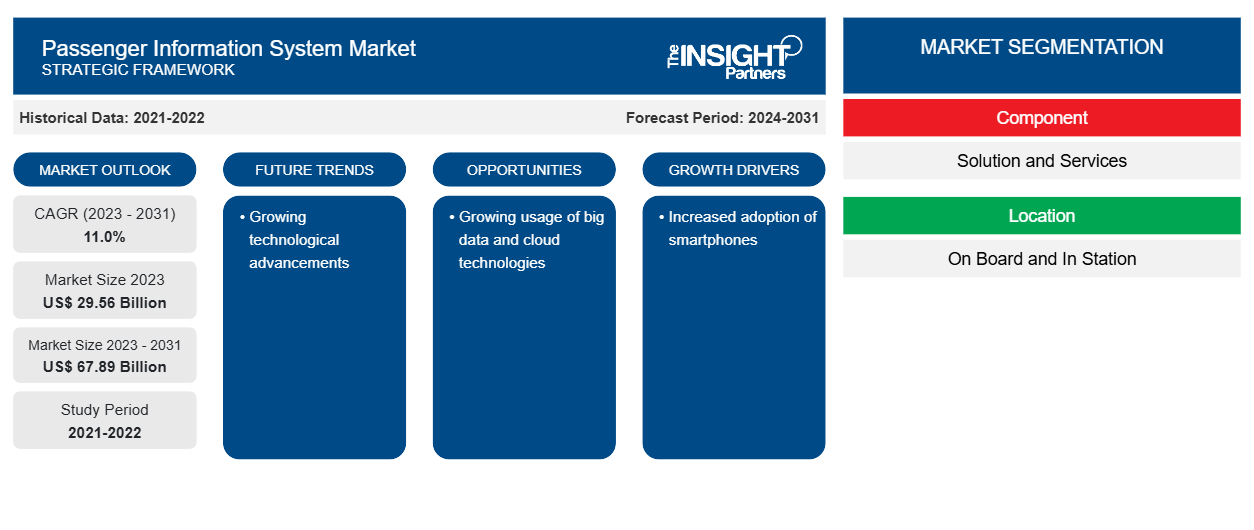Se proyecta que el tamaño del mercado de sistemas de información de pasajeros alcance los 67.890 millones de dólares estadounidenses en 2031, frente a los 29.560 millones de dólares estadounidenses en 2023. Se espera que el mercado registre una CAGR del 11,0 % entre 2023 y 2031. Es probable que los avances tecnológicos crecientes sigan siendo tendencias clave del mercado de sistemas de información de pasajeros.
Análisis del mercado de sistemas de información de pasajeros
La demanda de sistemas de información para pasajeros ha aumentado como resultado de varios factores, entre ellos el aumento del tráfico aéreo, el aumento de la adopción de sistemas de transporte inteligentes, el aumento de la penetración de soluciones de IoT en el sector del transporte y el aumento de la demanda de información de tránsito en tiempo real por parte de los pasajeros. Además, se prevé que el mercado de sistemas de información para pasajeros se beneficie del aumento de la demanda de toda la información relacionada con los viajes, desde los planificadores de viajes hasta las variaciones en los horarios de salida previstos. Además, se prevé que una mayor concienciación entre las agencias de transporte sobre la necesidad de ofrecer a los clientes una mejor experiencia de viaje estimulará la expansión del mercado.
Descripción general del mercado de sistemas de información de pasajeros
El objetivo de un sistema de información para pasajeros es proporcionar a los pasajeros información actualizada a través de dispositivos de audio , vídeo y multimedia sobre el estado y el tipo de servicios de transporte. Consiste en una colección de componentes de hardware y TI. También proporciona servicios de noticias y entretenimiento, así como detalles sobre la hora prevista de llegada y salida, todo lo cual contribuye a una mejor experiencia de viaje. El mercado de sistemas de información para pasajeros se está expandiendo debido a la creciente necesidad de que las agencias de transporte proporcionen a los pasajeros información de tránsito precisa y confiable en tiempo real. Además, el mercado se está expandiendo debido a los avances en la industria de las telecomunicaciones que permiten capacidades de transferencia de datos más rápidas, un aumento en la adopción de IoT en el sector del transporte y un aumento en la demanda de sistemas de transporte inteligentes.
Personalice este informe según sus necesidades
Obtendrá personalización en cualquier informe, sin cargo, incluidas partes de este informe o análisis a nivel de país, paquete de datos de Excel, así como también grandes ofertas y descuentos para empresas emergentes y universidades.
-
Obtenga las principales tendencias clave del mercado de este informe.Esta muestra GRATUITA incluirá análisis de datos, desde tendencias del mercado hasta estimaciones y pronósticos.
Factores impulsores y oportunidades del mercado de sistemas de información de pasajeros
Aumento de la adopción de teléfonos inteligentes
Debido al aumento del uso de teléfonos inteligentes, los sistemas de información para pasajeros basados en aplicaciones móviles están ganando popularidad rápidamente. Además, las agencias de transporte se están concentrando en aplicaciones móviles de sistemas de información para pasajeros para atraer clientes y darles acceso a información rápida, precisa y en tiempo real a través de los canales de los teléfonos inteligentes. Asimismo, el auge de las aplicaciones de tránsito multimodal para el transporte público presenta una oportunidad para la expansión del mercado.
Uso creciente de big data y tecnologías en la nube
Los ferrocarriles, en particular, están utilizando la computación en la nube para automatizar muchas formas de transporte. Mediante la tecnología de computación en la nube, el sistema de información de pasajeros rastrea la ubicación de los autobuses en las cercanías y determina la hora de llegada, que luego se muestra en el sistema de información en tiempo real en la parada de autobús. El uso de la tecnología en la nube y las soluciones de análisis de datos contribuyen a la asignación eficiente de recursos y al monitoreo económico de la población de pasajeros.
Análisis de segmentación del informe de mercado del sistema de información de pasajeros
Los segmentos clave que contribuyeron a la derivación del análisis del mercado del sistema de información de pasajeros son el componente, la ubicación, el modo de transporte y el modelo funcional.
- Según los componentes, el mercado de sistemas de información para pasajeros se divide en soluciones y servicios. El segmento de soluciones tuvo una mayor participación de mercado en 2023.
- Por ubicación, el mercado se segmenta en a bordo y en la estación. El segmento a bordo tuvo la mayor participación del mercado en 2023.
- En términos de modo de transporte, el mercado se divide en carreteras, ferrocarriles, vías navegables y vías aéreas. El segmento de las carreteras dominó el mercado en 2023.
- Por modelo funcional, el mercado está segmentado en pantallas multimedia, sistemas de audio, sistemas informáticos, dispositivos de redes y comunicaciones, videovigilancia y sistemas de gestión de contenidos.
Análisis de la cuota de mercado de los sistemas de información de pasajeros por geografía
El alcance geográfico del informe de mercado de sistemas de información para pasajeros se divide principalmente en cinco regiones: América del Norte, Asia Pacífico, Europa, Oriente Medio y África, y América del Sur/América del Sur y Central. América del Norte controlaba el mercado global de sistemas de información para pasajeros. Además, durante el tiempo proyectado, el mercado norteamericano probablemente aumentará a un ritmo alto. El factor principal que impulsa la expansión del mercado en esta área es el aumento tanto de la producción como del consumo de sistemas de información para pasajeros en las economías desarrolladas y en desarrollo de América del Norte. El PIS se considera uno de los mercados más grandes, con un uso notablemente alto de tecnología de punta y una infraestructura de red sólida. El área tiene un impacto significativo en la expansión del mercado de sistemas de información para pasajeros debido a elementos que incluyen el mayor uso del transporte público y el rápido ritmo de urbanización. Además, se anticipa que el creciente uso de servicios y soluciones de sistemas de información para pasajeros fomentará su expansión. Todos estos factores contribuyen al crecimiento del mercado de sistemas de información para pasajeros en la región.
Perspectivas regionales del mercado de sistemas de información de pasajeros
Los analistas de Insight Partners explicaron en detalle las tendencias y los factores regionales que influyen en el mercado de sistemas de información de pasajeros durante el período de pronóstico. Esta sección también analiza los segmentos y la geografía del mercado de sistemas de información de pasajeros en América del Norte, Europa, Asia Pacífico, Oriente Medio y África, y América del Sur y Central.

- Obtenga los datos regionales específicos para el mercado de sistemas de información de pasajeros
Alcance del informe de mercado de sistemas de información de pasajeros
| Atributo del informe | Detalles |
|---|---|
| Tamaño del mercado en 2023 | US$ 29,56 mil millones |
| Tamaño del mercado en 2031 | US$ 67.89 mil millones |
| CAGR global (2023 - 2031) | 11,0% |
| Datos históricos | 2021-2022 |
| Período de pronóstico | 2024-2031 |
| Segmentos cubiertos |
Por componente
|
| Regiones y países cubiertos |
América del norte
|
| Líderes del mercado y perfiles de empresas clave |
|
Densidad de actores del mercado: comprensión de su impacto en la dinámica empresarial
El mercado de sistemas de información para pasajeros está creciendo rápidamente, impulsado por la creciente demanda de los usuarios finales debido a factores como la evolución de las preferencias de los consumidores, los avances tecnológicos y una mayor conciencia de los beneficios del producto. A medida que aumenta la demanda, las empresas amplían sus ofertas, innovan para satisfacer las necesidades de los consumidores y aprovechan las tendencias emergentes, lo que impulsa aún más el crecimiento del mercado.
La densidad de actores del mercado se refiere a la distribución de las empresas o firmas que operan dentro de un mercado o industria en particular. Indica cuántos competidores (actores del mercado) están presentes en un espacio de mercado determinado en relación con su tamaño o valor total de mercado.
Las principales empresas que operan en el mercado de sistemas de información de pasajeros son:
- CORPORACIÓN TELESTE
- Siemens AG
- GRUPO THALES
- CORPORACIÓN CÚBICA
- INDRA SISTEMAS SA
- ALSTOM
Descargo de responsabilidad : Las empresas enumeradas anteriormente no están clasificadas en ningún orden particular.

- Obtenga una descripción general de los principales actores clave del mercado de sistemas de información de pasajeros
Noticias y desarrollos recientes del mercado de sistemas de información de pasajeros
El mercado de sistemas de información para pasajeros se evalúa mediante la recopilación de datos cualitativos y cuantitativos a partir de investigaciones primarias y secundarias, que incluyen publicaciones corporativas importantes, datos de asociaciones y bases de datos. A continuación, se incluye una lista de los avances del mercado:
- En enero de 2021, para ampliar su actual cartera de tecnología de transporte, Cubic Corporation presentó "UMO", un conjunto de plataformas completamente integradas para movilidad, pasajeros, proveedores de servicios y autoridades de tránsito. UMO es un conjunto flexible de herramientas que permite a los usuarios programar viajes en transporte público y privado, pagarlos, obtener recompensas por viajar y recibir información actualizada para aumentar su movilidad.
(Fuente: Cubic Corporation, sitio web de la empresa)
- En junio de 2020, Wabtec Corporation presentó el dispositivo de filtración de aire "BlueFiIter" para brindar a los pasajeros de trenes y metros un ambiente limpio y saludable. En los vagones, BlueFilter elimina más del 90 % de los contaminantes.
(Fuente: Wabtec Corporation, sitio web de la empresa)
Informe de mercado sobre sistemas de información de pasajeros: cobertura y resultados
El informe "Tamaño y pronóstico del mercado del sistema de información de pasajeros (2021-2031)" proporciona un análisis detallado del mercado que cubre las siguientes áreas:
- Tamaño del mercado y pronóstico a nivel global, regional y nacional para todos los segmentos clave del mercado cubiertos bajo el alcance
- Dinámica del mercado, como impulsores, restricciones y oportunidades clave
- Principales tendencias futuras
- Análisis detallado de las cinco fuerzas de Porter y PEST y FODA
- Análisis del mercado global y regional que cubre las tendencias clave del mercado, los principales actores, las regulaciones y los desarrollos recientes del mercado.
- Análisis del panorama de la industria y de la competencia que abarca la concentración del mercado, el análisis de mapas de calor, los actores destacados y los desarrollos recientes
- Perfiles detallados de empresas
- Análisis histórico (2 años), año base, pronóstico (7 años) con CAGR
- Análisis PEST y FODA
- Tamaño del mercado, valor/volumen: global, regional y nacional
- Industria y panorama competitivo
- Conjunto de datos de Excel
Informes recientes
Testimonios
Razón para comprar
- Toma de decisiones informada
- Comprensión de la dinámica del mercado
- Análisis competitivo
- Información sobre clientes
- Pronósticos del mercado
- Mitigación de riesgos
- Planificación estratégica
- Justificación de la inversión
- Identificación de mercados emergentes
- Mejora de las estrategias de marketing
- Impulso de la eficiencia operativa
- Alineación con las tendencias regulatorias























 Obtenga una muestra gratuita para - Mercado de sistemas de información de pasajeros
Obtenga una muestra gratuita para - Mercado de sistemas de información de pasajeros